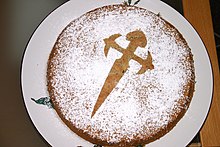Cross of Saint James – Wikipedia
From Wikipedia, the free encyclopedia
Heraldic symbol, emblem of the Spanish Order of Santiago

The Cross of Saint James, also known as the Santiago cross, cruz espada, or Saint James’ Cross, is a heraldic badge that is cruciform in design. The cross, shaped as a cross fitchy, combines with either a cross fleury or a cross moline. Its most common version is a red cross resembling a sword, with the hilt and the arm in the shape of a fleur-de-lis.
It gets its name from James the Greater and the account of his appearance at the Battle of Clavijo in the Spanish victory over the Moors. It is used widely throughout Spain and Portugal.
Background[edit]
In heraldry, the cross is also called the Santiago cross or the cruz espada (English: sword cross).[1] It is a charge, or symbol, in the form of a cross. The design combines a cross fitchy or fitchée, one whose lower limb comes to a point, with either a cross fleury,[2] the arms of which end in fleurs-de-lis, or a cross moline,[1] of which the ends of the arms are forked and rounded.
The most common version is a red cross resembling a sword, with the shape of a fleur-de-lis on the hilt and the arms.[3][4] The three fleurs-de-lis represent the “honor without stain,” which is in reference to the character of the Apostles. The sword is said to represent both the courage of James, and the manner of his martyrdom,[5] as he was beheaded with a sword.[6]
The insignia is said to have originated from the mythical[7]Battle of Clavijo, wherein Saint James appeared to Ramiro I of Asturias after the king prayed to the patron saint of Galicia for help leading the army to victory over the Moors.[8]
A comparison of the crosses that make up the Cross of St. James:

Medieval Pilgrims embarking on the Camino de Santiago would bring a pastry with them on their way to St. James’ shrine in Galicia.[9] Since the early part of the 20th century, the cross has been used as a decorative element on the almond pastry Tarta de Santiago.[10] A traditional Galician dessert made from ground almonds, the top of the pie is decorated with powdered sugar, masked by an imprint of the cross which gives the dessert its name.[11]
A red cross on a white field is a common design for a Christian cross. The cross is the symbol of the crucifixion, the white color symbolizing purity, and the red color symbolizes the blood of Christ.[8] A red Cross of Saint James, with flourished arms and scalloped top, over a field of white was the emblem of the 12th-century Spanish Order of Santiago and Portuguese Military Order of Saint James of the Sword. Both were named after James the Greater.[2][4]
In Spain, the Order of Santiago, a religious and military order founded in the 12th century, was founded to protect the pilgrims on the Camino, and to defend Christendom against the Moors then on the Iberian Peninsula.[12] Knights of the order wore the cross stamped on the their standards and white capes.[13]
On the Camino, the cross is often seen with a Pilgrim’s scallop to mark the way of the pilgrimage.[3] It is said that the “fitchy” shape originated in the era of the Crusades, when the knights took with them small crosses with sharpened bottoms to stick them in the ground[14][15] and carry out their daily devotions.[9]
Gallery[edit]
- Examples of the cross displayed on the Way of Saint James
-

A pavement marker indicates the route of the Way of St James through Navarrete, La Rioja, Spain
-

Waymark of the Way of St. James (white shell, red cross) in the city center of Zittau, Saxony, Germany.
- Examples of the cross displayed throughout Spain
- Examples of the cross in art
Further reading[edit]
See also[edit]
References[edit]
- ^ a b Davies, Nikolas; Jokiniemi, Erkki (2012). Dictionary of Architecture and Building Construction. Routledge. p. 104. ISBN 9781136410253.
- ^ a b Berry, William (1828). Encyclopaedia Heraldica Or Complete Dictionary of Heraldry, Volume 1. Sherwood, Gilbert and Piper. p. 177.
Cross of St. James is a red sword, formed at the hilt like a cross flory and charged with an escallop.
- ^ a b “The symbolic power of the Way of St. James”. Five Sensations. August 25, 2015. Retrieved August 25, 2015.
- ^ a b
 Herbermann, Charles, ed. (1913). “Order of Saint James of Compostela“. Catholic Encyclopedia. New York: Robert Appleton Company.
Herbermann, Charles, ed. (1913). “Order of Saint James of Compostela“. Catholic Encyclopedia. New York: Robert Appleton Company.
- ^ [Acts 12:1–2]
- ^ St. James. Encyclopedia Britannica. January 1, 2022.
- ^ “Saint James the Greater at the Battle of Clavijo|Blanton Museum of Art Collections”. utw10658.utweb.utexas.edu. Retrieved July 20, 2022.
- ^ a b “Galician Christian Crosses: Saint James’ Cross, Patron Saint of Galicia”. www.galicianflag.com. Retrieved July 15, 2022.
- ^ a b “Cross of St. James”. www.seiyaku.com. Retrieved July 15, 2022.
- ^ “Postres del Mundo. Galicia: La Tarta de Santiago”. Viajar Y Celebrar (in Spanish). August 8, 2017.
- ^ “COUNCIL REGULATION (EC) No 510/2006 ‘TARTA DE SANTIAGO’ EC No: ES-PGI-0005-0616-03.07.2007”. Official Journal of the European Union. Retrieved April 6, 2014.
- ^ Linehan, Peter (2011). Spain:A Partible Inheritance, 1157-1300. Blackwell Publishing Ltd. ISBN 978-1444339758.
- ^ Gallego Blanco, Enrique (1971). The Rule of the Spanish Military Order of St. James – 1170-1493. Brill.
- ^ Gilman, D. C.; Peck, H. T.; Colby, F. M., eds. (1905). . New International Encyclopedia (1st ed.). New York: Dodd, Mead.
- ^ Rines, George Edwin, ed. (1920). . Encyclopedia Americana.
External links[edit]
Recent Comments